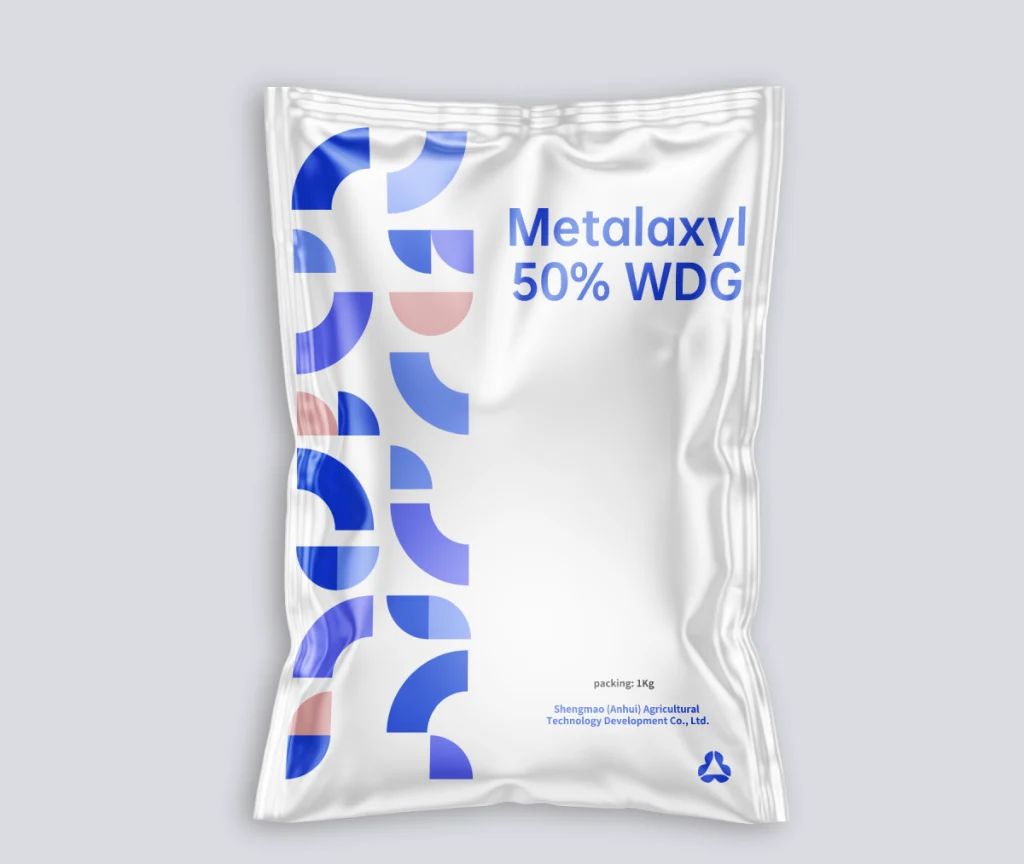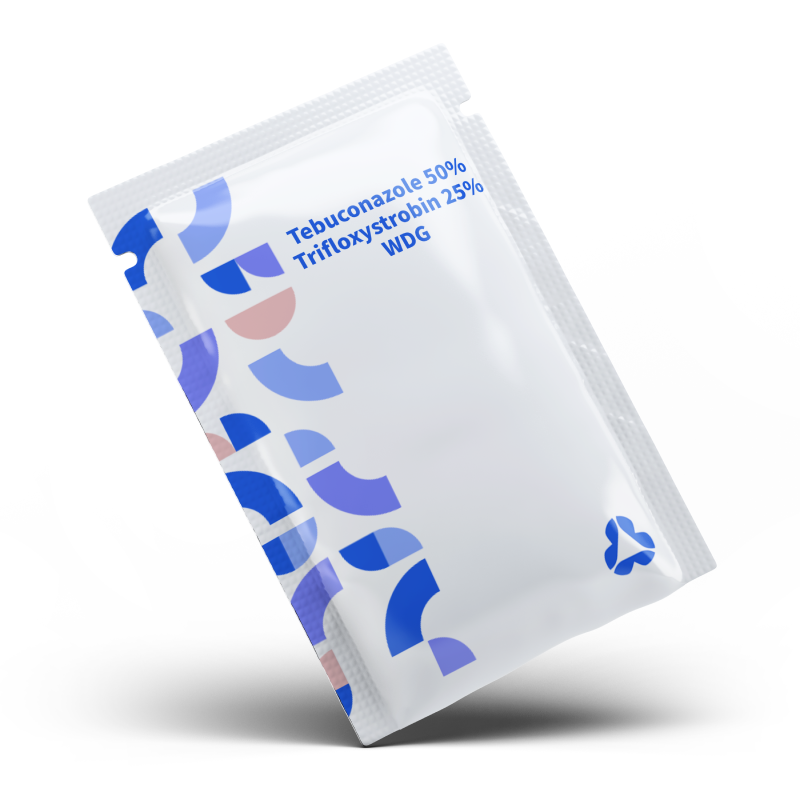- Active Ingredient: Propiconazole (CAS No. 60207-90-1)
- Molecular Formula: C₁₅H₁₇Cl₂N₃O₂
- Mode of Action: Inhibits CYP51 (sterol 14α-demethylase), blocking ergosterol synthesis in fungal cell membranes.
- Formulation: 250g/L EC (Emulsifiable Concentrate)
- Physical State: Yellow to brown liquid
- Solubility: 100 ppm in water; soluble in acetone, xylene
- Vapor Pressure: 4.0×10⁻⁸ mmHg at 25°C
- pH Range: 5.0–8.0 (stable in neutral to slightly acidic conditions)
- Systemic Uptake: Absorbed through leaves and roots, translocating via xylem to untreated tissues.
- Target Disruption: Binds to CYP51 enzyme, preventing demethylation of lanosterol to ergosterol.
- Cell Membrane Collapse: Weakened membranes lead to leakage of cellular contents and fungal death.
- Symptom Control: Halts mycelial growth, spore production, and disease progression within 24–48 hours.
| Crop |
Target Diseases |
Dosage (L/ha) |
Timing |
| Wheat |
Leaf rust, powdery mildew |
0.5–1.0 |
Flag leaf emergence |
| Barley |
Net blotch, scald |
0.4–0.8 |
Tillering to stem elongation |
| Rice |
Sheath blight, blast |
0.6–1.2 |
Boot stage |
| Grapes |
Powdery mildew, black rot |
0.8–1.5 |
Pre-bloom to veraison |
| Turfgrass |
Brown patch, dollar spot |
0.3–0.6 |
At first sign of disease |
- Water Volume: 200–400 L/ha for foliar sprays; ensure thorough coverage.
- Adjuvants: Add non-ionic surfactant (0.25% v/v) to enhance leaf penetration.
- Rainfastness: 4–6 hours post-application.
- Mix Compatibility: Tank mix with mancozeb or chlorothalonil for broader spectrum control.
- Broad-Spectrum Control: Effective against 30+ pathogens, including rusts, mildews, and blights.
- Systemic Protection: Moves throughout the plant, protecting new growth.
- Residual Activity: 14–21 days of disease suppression, reducing application frequency.
- Crop Safety: Selective in cereals, fruits, and turf when used at labeled rates.
- Resistance Management: Rotate with strobilurins (e.g., azoxystrobin) or SDHIs (e.g., boscalid) to delay resistance.
- Toxicity:
- Low mammalian toxicity (LD₅₀ > 2000 mg/kg); harmful if inhaled.
- Moderately toxic to fish (LC₅₀ 2–5 mg/L); avoid water runoff.
- Environmental Fate:
- Soil half-life: 28–60 days (degrades via microbial activity).
- Low volatility; minimal risk of vapor drift.
- Standard: 1L, 5L, 20L COEX containers.
- Custom: Private labeling available for distributors.
Yes, in most cases. Propiconazole is commonly mixed with pyrethroids (e.g., deltamethrin), neonicotinoids (e.g.,
imidacloprid), or organophosphates (e.g.,
chlorpyrifos) for combined disease and pest control. Always check labels for specific compatibility statements.
With caution. Avoid mixing with highly acidic herbicides (e.g.,
glyphosate in acidic formulations) or alkaline herbicides (e.g.,
2,4-D salts), which may cause degradation or phytotoxicity. Test small batches before full application.
Yes, and it’s often recommended for resistance management. Compatible fungicides include:
- Chlorothalonil (protectant)
- Azoxystrobin (strobilurin)
- Mancozeb (dithiocarbamate)
Mixing systemic (propiconazole) and protectant fungicides broadens disease control.
Incompatible mixes may cause:
- Reduced efficacy (e.g., propiconazole degradation in alkaline conditions)
- Physical separation (precipitation, oil layers)
- Crop damage (phytotoxicity from formulation interactions)
- Add 100 ml water to a clear container.
- Add each pesticide at labeled rates.
- Stir and observe for 30 minutes. Avoid use if:
- Cloudiness, flakes, or oil droplets form.
- Excessive foaming or viscosity changes occur.
- Fill tank 1/3 with water.
- Add water-soluble products (e.g., fertilizers).
- Add wettable powders (WP).
- Add suspensions (SC).
- Add emulsifiable concentrates (EC, including propiconazole).
- Add adjuvants last.
- Fill remaining tank with water and agitate.
Yes, with water-soluble fertilizers (e.g., N-P-K, micronutrients). Avoid high-concentration fertilizers, which may increase leaf burn risk. Test compatibility first.
- Avoid mineral oils at high rates.
- Check HLB (hydrophilic-lipophilic balance) of surfactants; incompatible HLB values may cause emulsion breakdown.
- Non-registered adjuvants (e.g., homemade oils) are not recommended.
Generally no, if compatible. However, some protectant fungicides (e.g., mancozeb) may slightly reduce systemic movement of propiconazole. Follow label rates for optimal residual control (14–21 days).
Proceed with caution. Chemical fungicides like propiconazole may reduce the efficacy of biological agents. If needed, apply biologicals separately or at least 7 days apart.
Yes. Propiconazole is stable in pH 5–8. Alkaline mixes (pH >8) degrade the active ingredient, while highly acidic mixes (pH <5) may cause formulation instability. Test mix pH with litmus paper.
Yes. For example:
- On grapes, avoid mixing with certain sulfur-based fungicides.
- On turf, ensure the mix does not enhance stress during hot weather.
Always consult crop-specific label guidelines.
No. Prepare only the amount needed for immediate application. Most mixes are unstable after 24 hours, and efficacy may decline.
- Stop application immediately.
- Rinse crops with clean water to remove excess residue.
- Contact a local agronomist or extension service for damage assessment.
Yes. Avoid mixing triazoles (e.g., propiconazole + tebuconazole), as they share the same mode of action. Rotate with different classes (e.g., strobilurins) to manage resistance.
Yes. For example:
- In the EU, mixes must comply with MRL regulations.
- In the U.S., some state agencies require pre-approval for certain combinations.
Consult local agricultural authorities for compliance.
Yes, but use a non-ionic surfactant at 0.25% v/v (as labeled). Excessive surfactant may increase leaf burn risk, especially on sensitive crops (e.g., young seedlings).
Copper formulations are often alkaline, which can degrade propiconazole. Avoid mixing; if necessary, apply copper and propiconazole 7–10 days apart.
Yes. The PHI is determined by the longest PHI of any product in the mix. For example, if propiconazole has a 30-day PHI and an insecticide has a 14-day PHI, the mix’s PHI is 30 days.
- Product labels (primary source).
- Manufacturer technical bulletins.
- Local extension services (e.g., USDA Extension in the U.S.).
- Agronomic consultants specializing in your region and crop.



